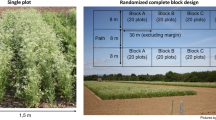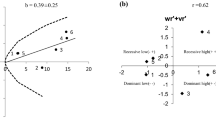Summary
Fourteen lines of linseed (Linum usitatissimum L.) were evaluated for general and specific combining ability through line × tester cross analysis using five diverse testers in two different environments. Seventy F1's and nineteen parental genotypes were raised in completely randomized block design with two replications with respect to yield and yield related traits. Considerable genetic variation was observed for all the traits studied. The additive as well as non-additive gene effects played significant role in the inheritance of yield and related traits with preponderance of non-additive gene effects for all the traits studied. Higher proportion of general combining ability × environment interaction variance as compared to specific combining ability × environment estimates was recorded. Additive genetic variances were more sensitive than non-additive genetic variances to the changing environment. Low estimates of heritability (narrow sense) for primary branches per plant, capsules per plant, seeds per capsule, seed yield per plant, harvest index and oil content and medium heritability for days to 50% flowering, days to maturity, plant height and 1000-seed weight was observed. Among the female parents LCK-9816, Parvati, Himalini, KL-168 were good general combiners for yield and related traits along with oil content, whereas among male parents, Surbhi and KL-224 were good general combiners for yield related traits and oil content but KL-221 was good general combiner for seed yield and related traits.
Similar content being viewed by others
References
AICRP (O), 2004. Annual Progress Report .All India Co- ordinated Research Project on Linseed (ICAR), Project coordinating unit (Linseed), C.S.A.U.A, Kanpur, p.1 . (Executive summary).
Allard, R.W., 1960. Principles of Plant Breeding. John Wiley and Sons. Inc. New York. pp. 123, 468.
Anonymous, 2005. Low cost production technology for oilseed crops. Directorate of Oilseeds Research Rajendranagar, Hyderabad (A.P.).
Bhateria, S., A. Pathania, J.K. Sharma, D. Badiyala & J.C. Bhandari, 2001. Combining ability for seed yield and its components in linseed (Linum usitatissimum L.). J Oilseeds Res 18(1): 44–47.
Dabholkar, A.R., 1992. Elements of Biometrical Genetics. Concept Publishing Company, New Delhi, pp. 187–214.
Dakhore, S.R., M.N. Narkhede & P.W. Khorgade, 1987. Combining ability for oil content in linseed. J Maharashtra Agric Univ 12: 308–310.
Dhakar, J.M., 1994. Studies on heterosis, combining ability and stability parameters in linseed (Linum usitatissimum L.). Unpublished Ph. D. Thesis. R.C.A.R.A.U., Udaipur.
FAO, 2002. Production Year book. Food and Agricultural Organization, Rome 56:127.
Gopalan, C., B.V. Ramasastri & S.C. Balasubramanian, 2005. Nutritive value of Indian foods. ICMR, Hyderabad (A.P.).
Hallaur, A.R. & J.P. Mirada, 1981. Quantitative genetics in maize breeding. Iowa State University Press Ames.
Jinks, J.L., 1983. Biometrical genetics of heterosis. R. Frankel (ed), New York. pp.1–46.
Kempthorne, O., 1957. An introduction to Genetic Statistics. John Wiley and Sons, New York, p.458.
Kumar, M., P.K. Singh & N.P. Singh, 2000. Line × tester analysis for seed yield and its components in linseed (Linum usitatissimum L.). Annals of Agricultural Research 21(4):485–489.
Mahto, C. & M.H. Rahman, 1998. Line × tester analysis of seed yield and its components in linseed (Linum usitatissimum L.). J Oilseeds Res. 15: 242–246.
Patel, J.A., Y.K. Gupta, S.B. Patel & J.N. Patel, 1997. Combining ability analysis over environments in linseed. Madras Agricultural Journal 84: 188–191.
Pathania, A., 1999. Genetic analysis involving exotic and indigenous linseed (Linum usitatissimum L.) genotypes. M.Sc.Thesis, CSK Himachal Pradesh Krishi Vishvavidyalaya, Palampur (H.P.).
Rai, M., H. Singh & D.M. Hegde, 2002. Oilseeds and Oils- Research and Development Needs. Indian Society of Oilseeds Research, Directorate of Oilseeds Research, Rajendranagar, Hyderabad (A.P.).
Ratnaparkhi, R.D., N.N. Kolte & P.W. Khorgade, 1998. Line × tester analysis for combining ability in linseed (Linum usitatissimum L.). PKV Research Journal 22: 3–6.
Singh, P.K., 2000. Gene action for seed yield and its components in linseed. Indian Journal of Genetics 60(3): 407–410.
Singh, R.K. & B.D. Chaudhary, 1977. Biometrical methods in quantitative genetic analysis. Kalyani Publishers, New Delhi.
Sukhatme, P.V. & V.N. Amble, 1985. Statistical Methods for Agricultural Workers, ICAR, New Delhi.
Thakur, H.L. & S. Bhateria, 1991. Line × tester analysis for combining ability in linseed. J Oilseeds Res 8: 14–19.
Tak, G.M., 1996. Gene action in linseed. Advances in Plant Sciences 9: 99–102.
Yadav, R.K. & S.B.L. Srivastava, 2002. Combining ability analysis over environments in linseed (Linum usitatissimum L.). Crop Research 23: 2, 277–282.
Author information
Authors and Affiliations
Corresponding author
Rights and permissions
About this article
Cite this article
Bhateria, S., Sood, S.P. & Pathania, A. Genetic analysis of quantitative traits across environments in linseed (Linum usitatissimum L.). Euphytica 150, 185–194 (2006). https://doi.org/10.1007/s10681-006-9106-7
Received:
Accepted:
Published:
Issue Date:
DOI: https://doi.org/10.1007/s10681-006-9106-7




